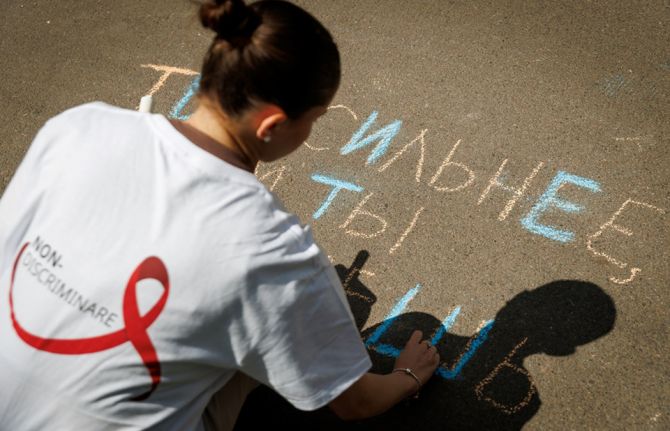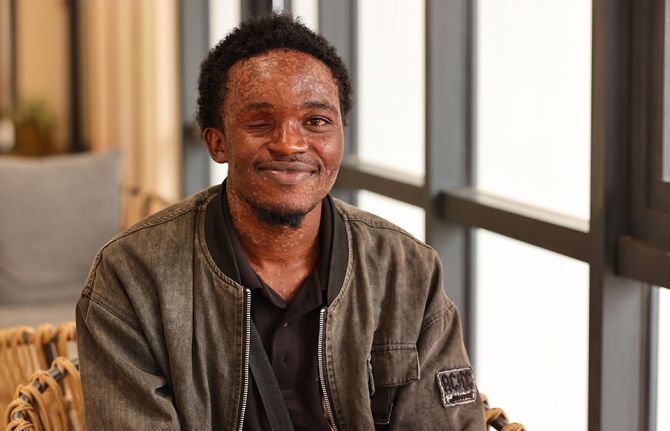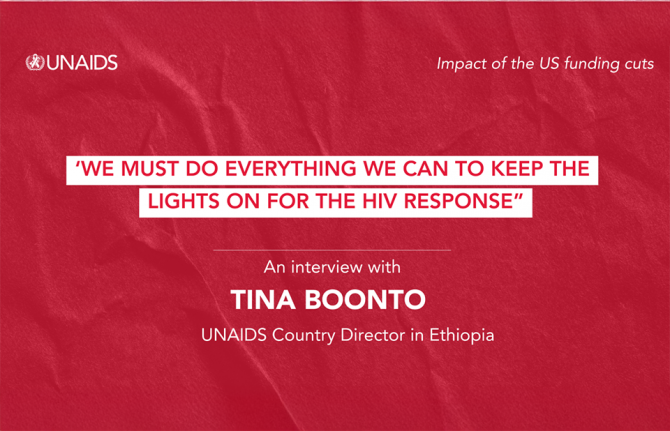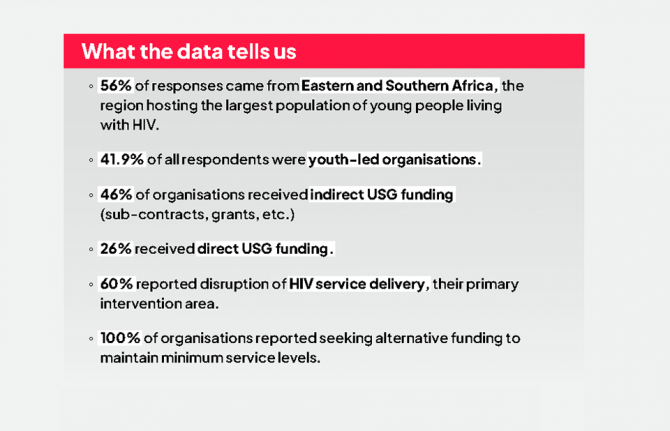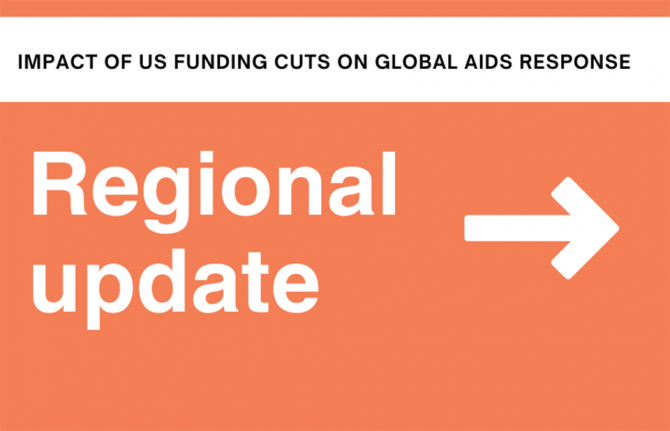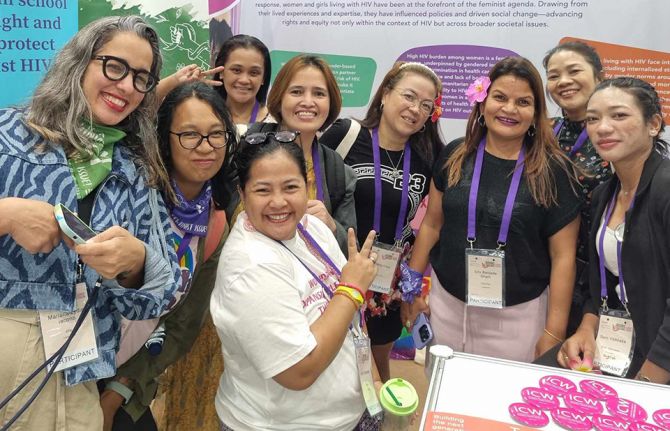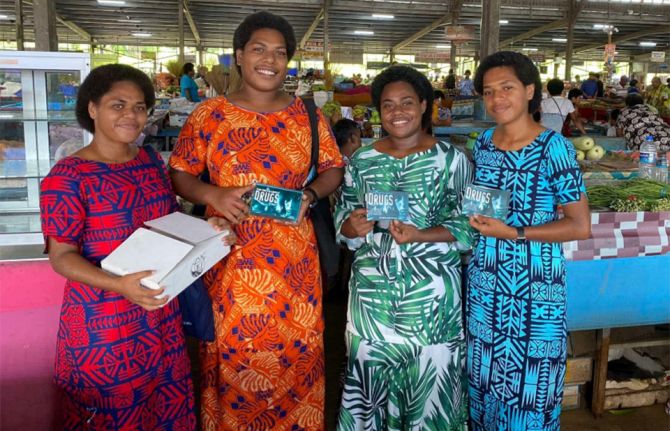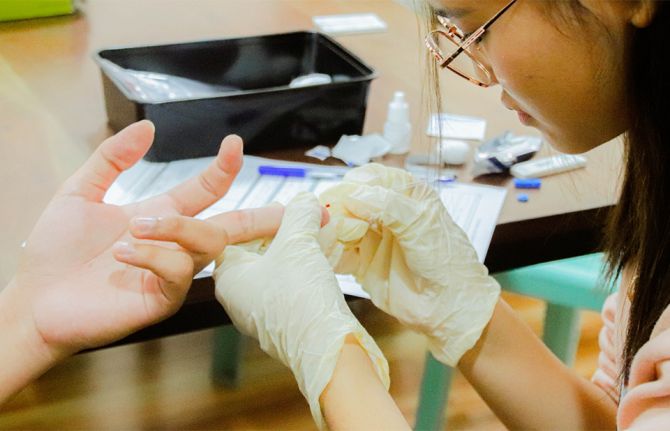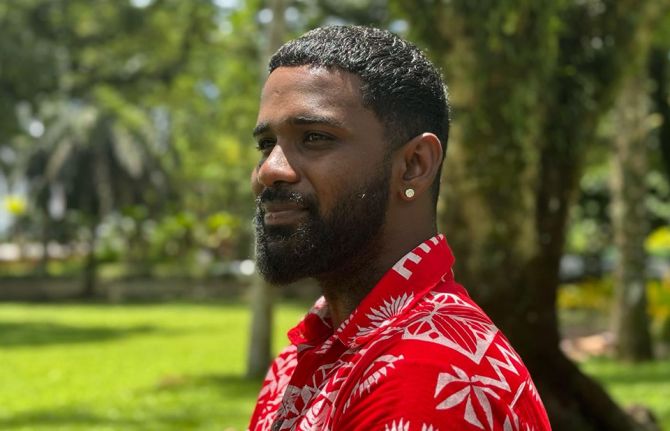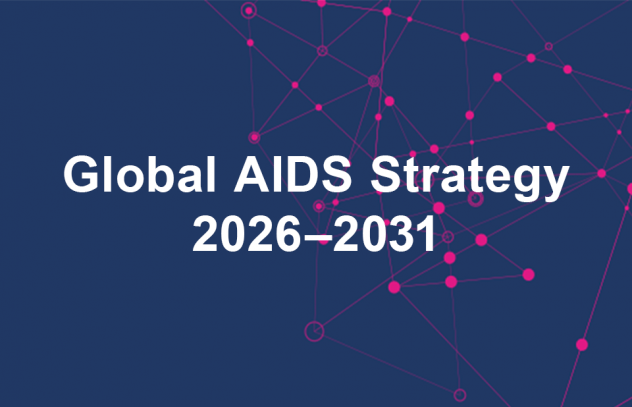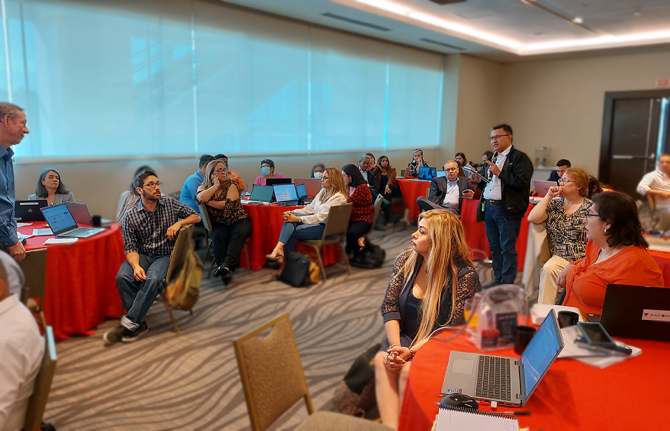
Feature Story
Leadership and AIDS: Patricia Pérez
08 April 2008
08 April 2008 08 April 2008
Since the early nineties Patricia Pérez has
raised her voice to speak out for and
advocate for the rights of women living
with or affected by HIV.
Leadership is the expression of a person whose aim is to transform something for the better and to develop this potential in others. Often leadership abilities are brought to the fore by certain crises in life enabling people to discover abilities that they didn’t know they had.
Activist Patricia Pérez is one such person. Since the early nineties she has raised her voice, along with other activists, to speak out for and advocate for the rights of women living with or affected by HIV.
Patricia Pérez was only 24 years old she found out she was HIV-positive. That was in 1986 and doctors told her that her life-expectancy would not be longer than two years. Today Pérez is the coordinator of the Latin American branch of the International Community of Women Living with HIV/AIDS (ICW), an organization of truly global reach which she helped to found.
Personal journey of discovery
Patricia was working as a gymnastics teacher in the city of her birth, Buenos Aires, Argentina at the time of her HIV diagnosis. After the shocking news she could only think one week at a time and couldn’t imagine a future life.
One day she decided to no longer dwell exclusively on her own situation and shifted her focus to others. She formed a volunteer group at the Muniz Hospital for people living with HIV that met weekly together to listen and support each other. Perez realized that all people living with HIV shared specific needs and experiences and that strength came from connecting together in networks.
Five years later she took part in a demonstration in London of 10,000 people living with HIV and realised that she was not alone and the power of a collective voice.
Early days of ICW

In 1992 at age 30, Patricia helped found
the International Community of Women
Living with HIV/AIDS (ICW).
In 1992 at age 30, Patricia helped found the International Community of Women Living with HIV/AIDS (ICW). This milestone in the history women’s AIDS advocacy happened when she and a group of 30 HIV positive women from different countries were attending the 8th International Conference on AIDS held in Amsterdam that year. Inspired by the idea that by working together they could make a difference to the lives of all women living with HIV, they drew up a charter on improving the situation of women living with HIV.
Today ICW has 8,000 members in 57 countries and is the only international network led by and for of HIV positive women.
“While the epidemic continues to have a devastating impact on women, Pérez, and other positive leaders are vital voices against stigma and discrimination. They have led the way in advocating for prevention, treatment, care and support services for people living with HIV, including those specifically tailored to the needs of positive women,” said UNAIDS Senior Partnership Adviser, Kate Thomson.
Women and HIV
Perez continues today to advocate at regional and international levels for women’s rights and greater involvement of women in clinical trials and scientific research on drug efficacy and HIV progression. She regularly organizes symposia and conferences across Latin America and participates in international events.
Women comprise about half of all people living with HIV worldwide and in sub-Saharan Africa, where the epidemic is worst, they make up an estimated 57% of adults living with HIV, and three quarters of young people living with HIV on the continent are young women aged 15-24.
Leadership and AIDS: Patricia Pérez

Feature Story
African Ministers reaffirm commitment to Millennium Development Goals
04 April 2008
04 April 2008 04 April 2008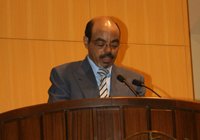
H.E Meles Zenawi, Prime Minister of the
Federal Democratic Republic of Ethiopia.
African Ministers of Finance and Development Planning concluded their 3-day meeting with a statement reaffirming their commitment to achieving the Millennium Development Goals (MDGs) in Africa by 2015. The statement called for Governments to act urgently to scale up public sector investments in infrastructure, agriculture, health and education. Special mention was made to fulfill the commitment made in the Abuja Declaration on HIV/AIDS, Tuberculosis and other related infectious diseases to allocate 15 per cent of their budgets to health issues.
As part of national strategies to achieve the MDGs and other internationally agreed goals, the Ministers resolved to increase domestic spending on the MDGs, ensuring that resources from debt relief, revenues from natural resources and other sources are channeled towards meeting the Goals.
In an address to the conference, UNAIDS Executive Director Dr. Peter Piot indicated that AIDS increases demands for state spending on health and welfare and at the same time depletes the workforce, reducing governments’ ability to raise taxes, in some countries by 20 per cent.
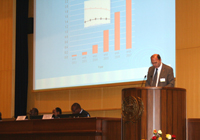
UNAIDS Executive Director Dr. Peter Piot
indicated that AIDS increases demands for
state spending on health and welfare and
at the same time depletes the workforce,
reducing governments’ ability to raise
taxes, in some countries by 20 per cent.
In several countries most affected by AIDS, there is a need for additional fiscal space for the AIDS response. How this space is created will depend on the individual situation of each country. Dr Piot emphasized the urgent need to change the eligibility criteria for overseas development assistance to reflect the extent of the epidemic and not base it on income levels alone. This will enable highly affected low and middle-income countries to benefit from favorable funding conditions and mechanisms.
The meeting of African Ministers of Finance, Planning and Economic Development Finance, which took place from 31st March to 2nd April, addressed new challenges facing Africa in the 21st century, and the new international economic environment within which they must be tackled.
African Ministers reaffirm commitment to Millenni
Feature stories:
African Ministers meet to discuss 21st century challenges (01 April 2008)
Multimedia:
Listen to UNAIDS Executive Director's presentation
External links:

Feature Story
Second stocktaking report on children and AIDS
03 April 2008
03 April 2008 03 April 2008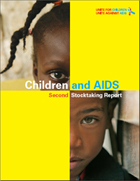
For millions of children, AIDS has starkly altered the experience of growing up. In 2007, it was estimated that 2.1 million children under age 15 were living with HIV and 15 million children had lost one or both parents to the virus . Millions more have experienced deepening poverty, school dropout and discrimination as a result of the epidemic.
Nonetheless, important progress has been made in reducing the spread of AIDS since UNICEF and UNAIDS issued a Call to Action to Unite for Children, Unite against AIDS in October 2005, according to the new ‘Children and AIDS: Second stocktaking report’.
The report, co-authored by UNICEF, UNAIDS and WHO reviews progress made on children and AIDS in four key areas: Preventing mother-to-child transmission of HIV; Provision of paediatric treatment; protection and support of children affected by AIDS; and prevention of infection among adolescents and young people.
Prevention mother-to-child transmission of HIV
The ‘Children and AIDS: Second stocktaking report’ highlights that improvement in preventing mother-to-child transmission of HIV (PMTCT) has seen the most significant gains. In 2005, only 11% of women living with HIV received drugs to prevent transmission of the virus to their children; however by the end of 2006 that figure had risen to 31%.
In 2006, Botswana reported that only 7% of infants born to HIV-positive mothers became infected with HIV, compared to 35–40% before the PMTCT programme began.
However, most of the 2.1 million children under 15 living with HIV in 2007 were infected before their birth, during delivery or while breastfeeding.
Provision of paediatric treatment
Advances in paediatric care have been equally dramatic. In 2005, only 70,000 children were receiving antiretroviral drugs (ARVs) but in 2006, that number had risen to 127,000 – a 70% increase in one year.
In South Africa , mortality was reduced by 75% in HIV-positive infants who were treated before they reached 12 weeks of age.
Protection and support of children affected by AIDS
The stocktaking report also show progress on the protection and care for children affected by AIDS in many countries and on their access to social services. Progress has also been made in school enrolment rates for children who have lost both parents to the disease, although children affected by HIV are still more likely to fall behind in school and to live in poorer households.
Prevention of HIV infection among adolescents and young people
The report highlights the urgent need for better evidence-based information on the behaviours of adolescents and young people to improve and focus HIV prevention efforts to where they will be most effective. It also outlines the importance of involving young people in the design, implementation and monitoring of HIV prevention programmes for young people.
In Latin America and the Caribbean, MTV has been working with UNICEF to produce ‘Sexpress Yourself’, a one-hour special in which young people talk openly and honestly about sex, sexuality, gender roles and HIV.
In India, focused peer outreach programmes, youth-friendly health services and communication activities in 43 high-prevalence districts are helping to reach adolescents, young people and especially girls at high risk.
While the news is mixed, the report argues that achieving an AIDS-free generation is possible. For that, the report calls for action to strengthen communities and families whose role is crucial to every aspect of a child-centred approach to AIDS; reinforce health, education and social welfare systems to support children affected by AIDS; integrate services for PMTCT programmes; and consolidate data in order to document advances and shortfalls and strengthen commitment.
Second stocktaking report on children and AIDS
Cosponsors:
Press center:
Feature stories:
Signs of progress in global response to Children and AIDS (16 January 2007)
Publications:
Children and AIDS - Second Stocktaking report (pdf, 2.45 Mb)
Related
 “Who will protect our young people?”
“Who will protect our young people?”

02 June 2025

Feature Story
2008 HIV/AIDS Implementers' meeting
02 April 2008
02 April 2008 02 April 2008The HIV/AIDS Implementers' Meeting will take place June 3-7, 2008, in Kampala, Uganda. This year's theme is "Scaling Up Through Partnerships: Overcoming Obstacles to Implementation." The meeting theme recognizes the rapid expansion of HIV programmes worldwide.
Together, implementers will exchange best practices and lessons learned during the implementation of AIDS programmes, with a focus on building the capacity of local prevention, treatment, and care programs; maintaining quality control; and coordination among partners.
Visit the official web site
2008 HIV/AIDS Implementers' meeting
External links:
Related

Feature Story
African Ministers meet to discuss 21st century challenges
01 April 2008
01 April 2008 01 April 2008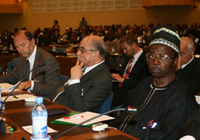
Participants will focus on issues such as
poverty reduction, state capacity to
promote and guide development, rising
oil prices and the global credit crisis.
The first session of the Joint Annual Meetings of the African Union Conference of Ministers of Economy and Finance and the United Nations Economic Commission for Africa Conference of Ministers of Finance, Planning and Economic Development is taking place in Addis Ababa, Ethiopia from 31 March to 2 April 2008.
The conference will also mark the start of a yearlong commemoration of the Economic Commission for Africa’s 50th anniversary. As part of the celebrations, participants, including selected African Heads of State and Government and other eminent persons, will be invited to reflect on the theme of the Conference, ‘Meeting Africa’s New Challenges in the 21st Century’.
The conference will begin with an overview of recent economic and social developments in Africa which will include the state of the global economy, overall growth performance in Africa, trends in social development in Africa and the continents economic prospects for 2008.
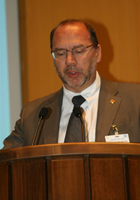
UNAIDS Executive Director Dr
Piot will highlight ways in
which the AIDS response can
be stepped up in Africa.
Participants will go on to focus on issues such as poverty reduction, state capacity to promote and guide development, particularly in relation to providing adequate infrastructure and social services, rising oil prices and the global credit crisis.
Four high-level thematic debates will be held on; HIV: keeping the promise; Empowering the poor; Growth, employment and poverty; and Climate change and development.
UNAIDS Executive Director, Dr Peter Piot will lead the debate on HIV and highlight that in spite of efforts to address the epidemic in Africa, AIDS remains a significant challenge which is hampering efforts to achieve the Millennium Development Goals. Dr Piot will highlight ways in which the AIDS response can be stepped up in Africa and will outline some specific recommendations for sustainable financing.
Photo credit: G. Bekele
African Ministers meet to discuss 21st century ch
External links:

Feature Story
Women leading the AIDS response in Latin America
28 March 2008
28 March 2008 28 March 2008
The meeting, supported by UNAIDS and
UNFPA, brought First Ladies and women
leaders from around the region together to
discuss ways of moving the AIDS response
forward.
The Coalition of First Ladies and Women Leaders of Latin America on Women and AIDS held its IV meeting in the Dominican Republic on 27 and 28 March 2008. The meeting, supported by UNAIDS and UNFPA, brought First Ladies and women leaders from around the region together to discuss ways of moving the AIDS response forward. The newly created Caribbean Coalition on Women, Girls and AIDS also participated in the event bringing vital impetus in addressing the challenges faced by women and girls in the Caribbean.
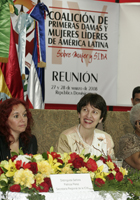
UNAIDS Deputy Executive
Director Deborah Landey
stressed the importance of
speaking on women and
AIDS.
UNAIDS Deputy Executive Director Deborah Landey stressed the importance of speaking on women and AIDS. She said, “You are here because you are ready to speak out and act on issues facing women. This takes courage. It is not always easy to talk about AIDS because it involves talking about issues many people prefer not to mention. So I congratulate you for being prepared to stand up and speak out.”
The Coalition was set up in 2006 under the leadership of the First Lady of Honduras, Mrs. Xiomara Castro de Zelaya, to promote political commitment and mobilization of regional and national resources to strengthen and enhance HIV prevention, treatment and care services and reduce the impact of the epidemic on women and girls.
The meeting in the Dominican Republic was hosted by the country’s First Lady Dr Margarita Cedeño de Fernández. The President of the Coalition and First Lady of Honduras Mrs Xiomara Castro de Zelaya also attended the meeting along with the First Ladies of Guatemala, Sandra Torres de Colom; Surinam, Liesbeth Anita María Venetiaan-Vanenburg and Panamá, Vivian Fernández de Torrijos; as well as representatives of MÉxico, Ecuador, Haití, El Salvador, Costa Rica and Chile.
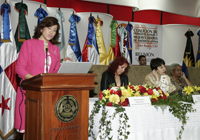
The meeting in the Dominican Republic
was hosted by the country’s First Lady Dr
Margarita Cedeño de Fernández.
The meeting took place under the theme "Stopping the feminization of the epidemic: Prevention and Care within Family and Community Context ". Sessions included; Women and HIV in the Dominican Republic; Living with HIV within the family and community context; and Cooperation for Development: Generating alliance for stopping the feminization of the epidemic and to obtaining universal access to HIV prevention, treatment, care and support.
A session was also dedicated to discussing the next steps for implementing the Action Platform in the run up to the International AIDS Conference, being held in Mexico in August 2008. The Action Platform is a strategy which was approved at the second meeting of the Coalition held in Buenos Aires in April 2007 which was designed to mitigate the impact of AIDS in the region, particularly focusing on actions to achieve universal access to HIV prevention, treatment, care and support. The platform also aims to promote women rights in a supportive environment, free of stigma and discrimination. The session included an analysis of the Action Platform to assess progress and to identify weaknesses and opportunities for further action.
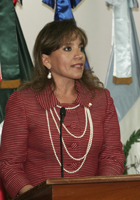
The Coalition was set up in
2006 under the leadership of
the First Lady of Honduras,
Mrs. Xiomara Castro de Zelaya
A project to implement a system of micro-credits for women living with HIV in the region was presented during the meeting which was an initiative, supported by the Nobel peace prize and UNAIDS Special Representative Mr. Mohamed Yunus. The project focuses on ways of empowering women to stand up to violence, protect themselves against HIV and achieve greater respect among their families and communities.
A study on gender violence and HIV in several countries in the region produced by UNFPA was also presented at the meeting.
Photo credit: UNAIDS
Women leading the AIDS response in Latin America
Partners:
UNFPA
The Global Coalition on Women and AIDS
Press center:
Read UNAIDS Deputy Executive Director's opening remarks
Read UNAIDS Deputy Executive Director's panel intervention
Feature stories:
View photo gallery
Women join forces in Latin America (30 October 2007)
Interview with the First Lady of Honduras Xiomara Castro de Zelaya (pdf, 125 Kb)

Feature Story
Independent Commission on AIDS in Asia calls for countries to craft new responses
26 March 2008
26 March 2008 26 March 2008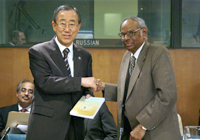
Professor C. Rangarajan (right), Chair of the Commission on AIDS in Asia, presented the report of the Commission to the United Nations Secretary-General Ban Ki-Moon, 26 March 2008.
Photo credit: UN Photo/Mark Garten.
High-impact interventions, such as HIV prevention programmes focused on key populations and antiretroviral treatment, should constitute the core of the HIV response across Asia recommends independent Commission on AIDS in Asia. Their new report, entitled “Redefining AIDS in Asia – Crafting an effective response”, was presented to the United Nations Secretary-General Ban Ki-Moon on 26 March at an event in New York.
The independent Commission on AIDS in Asia was created in June 2006 to give an opportunity to look at the unfolding realities of the HIV epidemic in Asia from a wide socioeconomic perspective reaching beyond the public health context.
In order to deliver on this mandate, nine leading economists, scientists, civil society representatives and policy-makers from across the region were appointed to the Commission which is led by Professor C. Rangarajan, Chief Economic Adviser to the Prime Minister of India.
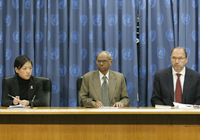
Press conference by Dr. Chakravarthi Rangarajan, Chairman of the Commission on AIDS in Asia and Chairman of the Economic Advisory Council to the Prime Minister of India (C); Dr. Peter Piot, Executive Director of UNAIDS (R); Ms. Frika Chia Iskandar, Coordinator, Asia Pacific Network of People Living with HIV and AIDS (L) . Photo credit: UN Photo/Mark Garten.
Welcoming the report, Dr Peter Piot, Executive Director of the Joint United Nations Programme on HIV/AIDS expressed his appreciation for the Commission’s efforts to bring a new perspective on the Asian epidemic, including its pragmatic recommendations.
“The findings of this report demonstrate the diversity of the AIDS epidemics in Asia and the need for countries to understand what is driving their epidemics and how to reach populations most at risk of HIV infection,” said Dr Piot.
AIDS epidemics in Asia
While recognizing that epidemics vary considerably from country to country across Asia, the report highlights certain shared characteristics. Epidemics centre mainly around behaviours of unprotected paid sex, use of contaminated needles and syringes by people who inject drugs, and unprotected sex between men. The Commission observes that the current classification of the epidemic as “low, concentrated and generalised” is inducing a sense of complacency among Asian Governments. The Commission urges UNAIDS and WHO to recommend a new classification based on the risk factors and burden of disease for low and concentrated epidemic countries.
The commission identified that in Asia the HIV epidemic is mainly driven by men who go for paid sex. Their number is estimated to be about 75 million in Asia and about 10 million women sell sex to these men. However the further transmission of the virus is limited by the sexual behaviour of women in an Asian context who generally do not have concurrent sexual partners.
So, by pragmatically focusing prevention programmes to the sex trade and on drug use, the commission suggests a considerable impact could be made by governments in halting and reversing the number of new infections across this region.
National response to HIV
The report acknowledges that effective and focused responses are underway in Cambodia, Thailand and parts of India but finds a lack of urgency or coherence in the response in many countries which is not enough to curb their epidemic. Heads of Governments of Asian countries should assume stronger leadership role, as according to the report in only two countries have they played a prominent role and officially provided leadership to the national AIDS programme.
To address concentrated epidemics requires leadership to overcome the social drivers behind the epidemic. These include structural and social factors, such as criminalization and marginalization of certain groups, human rights violations and discrimination. Failing to address these constitutes a major barrier to an effective national response.
Policy recommendations
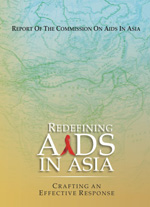
In order to address this, the report makes a series of strong recommendations for national governments around leadership, resource commitment, strategic information and community involvement.
Recommendations include the need for government and business leaders to assume a more proactive role in the HIV response and that community and civil society involvement should be ensured at all stages of policy, programme design, implementation and monitoring and evaluation.
Focusing on maximizing results, the report suggests specific government actions on prevention, treatment and care services. It recommends that impact mitigation programmes should be core to a national AIDS response and recommends better national monitoring and evaluation of epidemiological, behavioural and financial data in order for countries to acquire better knowledge of the epidemics and to determine the effectiveness of various strategic options.
Call for concerted and focused political will
Over an 18-month period, the Commission held five sub-regional and regional consultations, meeting more than 30 experts and 600 individuals and governmental and civil society groups, as well as reviewing more than 5,000 published and unpublished studies. Through its review and consultations with a broad range of stakeholders, the Commission has produced this set of findings and recommendations.
Nearly five million people are living with HIV in Asia with 440,000 people dying each year. If the current rate of transmission continues, the study contends, an additional eight million people will become newly infected by 2020.
The Commission on AIDS in Asia believes that governments in Asia have the potential to make the ambitious international targets–2001 Declaration of Commitment on HIV/AIDS as well as Millennium Development Goal 6 to halt and reverse the epidemic by 2015– a reality if they take the decisive steps set out in this new report.
Independent Commission on AIDS in Asia calls for
Press centre:
Read speech by United Nations Secretary-General
AIDS remains the leading cause of death and lost work days in the most productive age groups in Asia (26 March 2008)
Multimedia:
Webcast of the Press Conference: "Redefining AIDS in Asia – Crafting an Effective Response"
View photo gallery
Publications:
Download full report - Redefining AIDS in Asia: Crafting an effective response (pdf, 1.6 Mb)
Fact sheets Part 1 (pdf, 4 Mb)
Fact sheets Part 2 (pdf, 4 Mb)

Feature Story
UNAIDS launches global web sites in French, Spanish and Russian
20 March 2008
20 March 2008 20 March 2008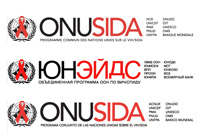
New UNAIDS global web sites in French, Russian and Spanish.
UNAIDS has launched the first phase of the new editions of its global web site in French, Spanish and Russian. For the first time parts of the web site are now available in each of the 4 official languages of the organization.
In a transparent process UNAIDS will continue to translate more of the content so where the Russian, Spanish and French versions are not yet available, the default language will be English. By later this year our aim is that 95% of the global web site will be in all four official languages.
We hope this step will enable us to reach a much wider audience across the globe giving many more internet users access to the data on the AIDS epidemic, key resources and the latest HIV news.
Increasing numbers of people have access to online communication technologies and can participate in vital information exchange. However a digital divide remains and UNAIDS recognizes that access inequality also includes a linguistic inequality as many policy, technical and scientific resources on the web are currently only available in English.
“Language is a critical tool for communication and fundamental to knowledge access,” said Chief of Communications and Knowledge Sharing, Annemarie Hou.
“By making our resources available in languages other than English we hope to reach across cultural and linguistic differences helping UNAIDS to deliver on its goal of supporting an expanded response to AIDS.”
The transmission of HIV is not limited by any social, cultural or linguistic boundary and as UNAIDS' response to HIV must reflect the diversity of the epidemic, our communication tools must also mirror the plurality that exists globally. The launch of our global web site in multiple languages is a further step in that direction, ensuring broader dissemination of our information tools and resources.
As a part of this strategy UNAIDS has partnered with the Faculty of Translation and Documentation of the University of Salamanca in Spain, to design new ways of developing communication on AIDS in Spanish.
The Spanish web content has been translated by the University students and this process, in addition to providing UNAIDS with high-quality translations, offers the opportunity to students to contribute to the work of the United Nations and gain increased awareness on AIDS issues at the same time.
UNAIDS looks forward to continuing this partnership with the University which also involves a terminology research project.
“Words may have different meanings in specific situations so it is very important to put them in context. We also need to make sure that the ideas behind terms and the meaning relations between them are clearly understandable by all the Spanish speakers worldwide,” said Vice Dean of the Faculty of Translation and Documentation, University of Salamanca, Dr Jesús Torres del Rey who coordinates the partnership project.
2008 International Year of Languages
The United Nations General Assembly proclaimed 2008 to be the International Year of Languages and has recognized that the United Nations should pursue multilingualism as a means of promoting, protecting and preserving diversity of languages and cultures globally and emphasized the paramount importance of the equality of the Organization’s official languages.
French
French is spoken by about 350 million people around the world as either a native or a second language, with significant populations in 54 countries. A majority of the world's French-speaking population lives in Africa where an estimated 115 million African people across 31 countries, can speak French either as a first or second language.
Spanish
Spanish is used by 370 million people across the globe and is the third most spoken language worldwide. In addition to Spain, Spanish is the official language of Argentina, Bolivia, Chile, Colombia, Costa Rica, Cuba, the Dominican Republic, Ecuador, El Salvador, Equatorial Guinea, Guatemala, Honduras, Mexico, Nicaragua, Panama, Paraguay, Peru, Uruguay, and Venezuela. In addition, it is widely spoken in Canada, Morocco, the Philippines, and the United States.
Russian
Russian is spoken as a first language by an estimated 167 million people and by an estimated 270 million in total. It is the official language of the Russian Federation, Belarus, Kazakhstan and Kyrgyzstan. It is spoken in 31 countries around the world including many of the former Soviet republics.
Please visit the global web sites in the following languages:
UNAIDS French-language global website at www.unaids.org/fr
UNAIDS Spanish-language global website at www.unaids.org/es
UNAIDS Russian-language global website at www.unaids.org/ru
We very much welcome your feedback. You can contact us with your ideas and suggestions by email: webmaster@unaids.org
UNAIDS launches global web sites in French, Spani
Cosponsors and partners:
UNESCO 2008 International Year of Languages
General Assembly proclaims 2008 International Year of Languages, in effort to promote unity in diversity, global understanding
Feature stories:
External links:
Related
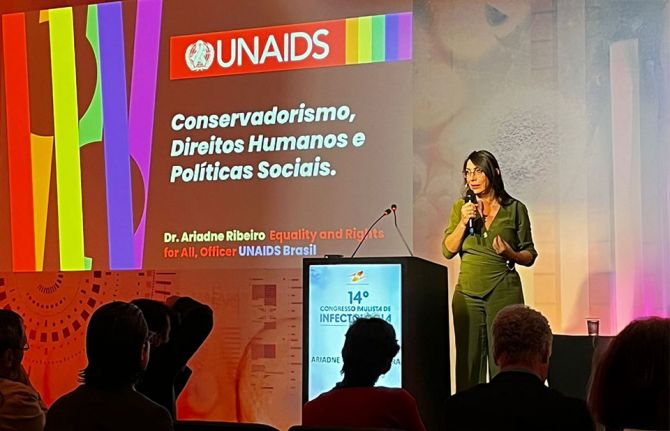 Upholding dignity for everyone: Ariadne Ribeiro Ferreira
Upholding dignity for everyone: Ariadne Ribeiro Ferreira

21 November 2024

Feature Story
TB deaths rise in people living with HIV
17 March 2008
17 March 2008 17 March 2008
(from left, front): Michel Kazatchkine, Executive Director, Global Fund; Margaret Chan, Director General, WHO); Peter Piot, Executive Director, UNAIDS; Jorge Sampaio, UN Secretary General’s Special Envoy to Stop TB and former president of Portugal and (from left, back): Jorge Bermudez, Executive Secretary of UNITAID; Mario Raviglione, Director WHO Stop TB Department; Marcos Espinal, Executive Secretary of the Stop TB Partnership at the launch of Global Tuberculosis Control 2008 report. Geneva, 17 March 2008.
Credit: WHO/C. Black
Almost quarter of a million people living with HIV died from tuberculosis (TB) in 2006 according to a new report published by the World Health Organization (WHO).
The annual report, Global Tuberculosis Control 2008, also shows that nearly 3/4 million people living with HIV fell ill with TB disease in 2006, confirming that TB is a major cause of illness and death in people living with HIV despite being mostly preventable and curable. Africa is yet again the most heavily affected continent, with 85% of the global burden of HIV-related TB.
The report also contained good news, with encouraging signs, especially from Africa, that TB and HIV programmes are increasingly working together to reduce the heavy burden of TB in people living with HIV. For example in Rwanda the TB programme were able to provide HIV testing to 76% of all TB patients, thus making sure that they were able to access the best HIV prevention, treatment and care services. Much more work is needed, however, to make sure that people living with HIV have better access to TB prevention, diagnosis and treatment services, e.g. less than 1% of people living with HIV were screened for TB in 2006.

Dr Peter Piot, Executive Director, UNAIDS addressed the press launch of Global Tuberculosis Control 2008. Geneva, 17 March 2008.
Credit: WHO/C. Black
"The report tells us that we are far from providing universal access to high-quality prevention, diagnostic, treatment and care services for HIV and TB," said Dr Peter Piot, Executive Director of UNAIDS.
"Clear progress has been made but we must all do more to make a joint approach to reducing TB deaths among people with HIV a reality."
The report was launched in Geneva by Peter Piot (Executive Director, UNAIDS), Margaret Chan (Director General, WHO), Michel Kazatchkine (Executive Director, Global Fund) and Jorge Sampaio (UN Secretary General’s Special Envoy to Stop TB and former president of Portugal) in time for World TB Day (24 March).
UNAIDS, WHO, the Global Fund, the Stop TB Partnership along with our national and international partners, will be working closely together to ensure universal access to integrated HIV and TB services and ensure a coordinated response to the epidemics of HIV and TB – this is the only way forward if we are to produce a truly effective response.
TB deaths rise in people living with HIV
Cosponsors:
Feature stories:
MDR-TB more common in people living with HIV (28 February 2008)
World TB Day events 2007 (30 March 2007)
TB Anywhere is TB Everywhere (24 March 2007)
Joining forces to tackle TB and HIV (24 November 2006)
Press centre:
Worldwide efforts to confront tuberculosis are making progress but too slowly (17 March 2008)
External links:
Publications:
Global Tuberculosis Control 2008 (pdf, 4.5Mb)
Frequently asked questions about Tuberculosis and HIV (33 Kb, pdf)
Frequently asked questions about XDR-TB (33 Kb, pdf)
Related
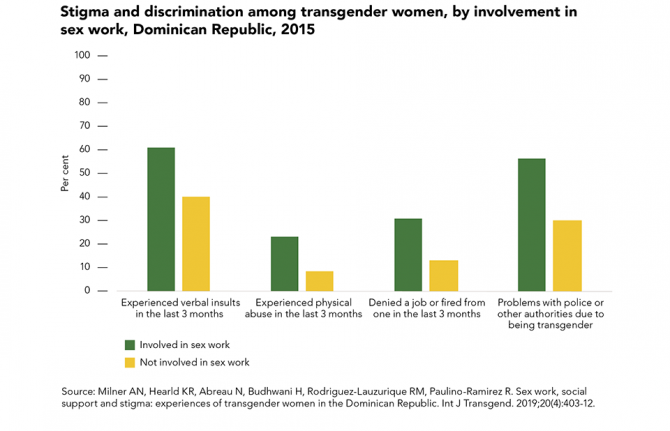 Transgender sex workers face frequent abuse
Transgender sex workers face frequent abuse

29 March 2022
 Many key populations avoid health services
Many key populations avoid health services

21 February 2022

Feature Story
Making a difference: Jamaica
14 March 2008
14 March 2008 14 March 2008
Miriam Maluwa, UNAIDS Country Coordinator for Jamaica, The Bahamas and Cuba, speaking at the launch of a Disability and HIV Programme in Jamaica, 3 December 2007
Credit: UNAIDS
“There are never enough hours in the day,” says Miriam Maluwa, Jamaica, the Bahamas & Cuba UNAIDS Country Coordinator. “The one thing I have learnt is that as country coordinator you have got to be responsive to the needs of the county. Like a constant half moon—there’s always the half you see and the other half that you can’t yet see, but you know is to come. And you need to be ready and responsive.”
Maluwa, who trained and practiced as a lawyer with experience of AIDS legal and human rights issues, joined UNAIDS headquarters ten years ago to head a unit on Law, Human Rights and HIV. In 2004 she was given the challenge of starting the new office for Jamaica, Cuba and the Bahamas, based in Kingston, Jamaica. “It’s not a job,” she says, “this is a personal mission. I see UNAIDS as a channel to fulfil that mission and I completely believe that I should be part of this.”
Leadership and advocacy
Alongside the unpredictable day-to-day demands and coordinating role, the office in Jamaica has a full agenda that is guided by the five UNAIDS strategic functions. Leadership and advocacy for the AIDS response has been an important one of these, and to date there have been many successes in this area. UNAIDS and its Cosponsors have put energy into moving the response beyond the health sector. As a result of this collaboration with the Government, in Jamaica there are now eight government ministries with policies and programmes for HIV.
UNAIDS Office and Cosponsors have also supported the government in the development of the Jamaica Strategic Plan for 2007- 2012, which is before the cabinet for endorsement. This $201 million plan has an integral Monitoring and Evaluation framework with embedded indicators and targets for its goal: “the achievement of universal access to prevention, treatment and care”.
Maluwa is very encouraged by the enthusiasm for the new plan. “It is so accepted that when the Prime Minister spoke at the last World AIDS Day breakfast Meeting he actually referred to the plan,” she said. “He spoke about its contents. He had no notes and he was speaking off the cuff. It was a good feeling.”
Jamaica's first ever private sector led Business Council on HIV and AIDS with 20 large companies was established in 2006.
One challenge in Jamaica is that few people know their HIV status or believe that they are at personal risk. An estimated three quarters of the some 25,000 people living with HIV in the country have not been diagnosed. The Prime Minister and his wife have drawn attention to this issue by taking HIV tests in public. During the 2007 official World AIDS Day event, which UNAIDS helped to organise, Voluntary Counselling and Testing facilities were provided and over 1000 people came forward for the service.

Miriam Maluwa, UNAIDS Country Coordinator for Jamaica, The Bahamas and Cuba speaking at a Prime Minister's World AIDS Day 2007 'Leadership for Life' breakfast meeting
Credit: UNAIDS
Legal reform
On the invitation of the authorities, UNAIDS Office has also played an active role in the process of HIV related legal reform. With her legal expertise Maluwa was able to support an extensive assessment of existing legislation and draw up reform proposals which have been submitted to Cabinet and discussed with the Parliamentary Joint Select Committee.
A series of reforms are being recommended including enactment of an anti Discrimination provision in the Jamaica Constitution prohibiting discrimination based on all status; amending the Public Health Act and enacting a comprehensive stand alone Anti Discrimination Act with mechanism to investigate and redress discriminatory actions and amending the Criminal Offences Act to decriminalize homosexuality.
“A lot of the value that Governments place on UNAIDS is on the technical support and our ability to provide strategic support at critical times,” says Maluwa.
Strengthening partnerships
The UNAIDS office also works to strengthen partnerships and support civil society. It has supported the development of a mini-TV series that will be broadcast in 2008. Called Red Ribbon Diaries, the series documents the lives of ordinary young Jamaicans affected by HIV. UNAIDS has also partnered with the Jamaica Council of Persons with Disabilities to implement an Island-wide prevention programme to educate deaf women and girls, and their service providers about HIV.
The Jamaican Network of Sero-positives (JN+) is supported through the provision of office space for its Board of Directors and UNAIDS also technically supports the network’s Island-wide capacity building workshops for people living with HIV and has served as Elections Returning Officer at the recently held elections of new JN+ Board.
Resource mobilisation
An achievement which Maluwa is particularly proud is UNAIDS Jamaica’s role in Chairing the Oversight Monitoring Committee of the Country Coordinating Mechanism which is implementing a model plan for resolving potential conflicts of interest between Principle Recipients and sub-recipients of the Global Fund to Fight AIDS, TB and Malaria.
This is part and parcel of the technical support to the Jamaican government, but has international relevance. “It is an innovative contribution to resource mobilisation. The Global Fund is currently publishing the Jamaica model as a Best Practice,” she said.
Personal fulfilment
Looking to the future, Miriam Maluwa sees the subsisting deep-seated culture of stigma, discrimination and homophobia as one of the main challenges to the Jamaica AIDS response.
However, important work is underway. The National AIDS Committee, in collaboration with UNAIDS Jamaica and the legal fraternity has secured free legal services from 25 lawyers to address matters of discrimination for people living with HIV and other key populations. These lawyers also support human rights workshops for the general public, media, religious leaders, people living with HIV and civil society to enhance a culture of tolerance.
“This work is personally rewarding,” says Maluwa, “because in the field you are not pushing paper, you are dealing with real issues every day. Each issue that comes to you, you are managing either the person before you or the relationship between that person and other partners you are trying to coordinate, so that everybody comes together over an issue. I find that very fulfilling because I can count on my fingers the difference that I am making every day.”
Her four years in the country office has given her new insights into UNAIDS. “The life of UNAIDS is really at country level,” she says. “It’s the best way for UNAIDS to showcase its work. Either we are there or we are irrelevant. I think the country offices bring credibility to UNAIDS, because they are what people see. We need to put our money and our efforts there.”
Making a difference: Jamaica
Feature stories:
Making a difference: UNAIDS in Ethiopia (8 February 2008)
Making a difference: UNAIDS in Ukraine (8 January 2008)



